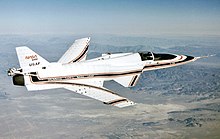United States X aircraft
The X aircraft are a series of experimental aircraft and missiles used by the US armed forces and NASA, respectively . They are used to research new technologies and / or construction methods, for which only a few copies of a type are usually produced. According to the designation system for aircraft of the US armed forces , the aircraft is given the prefix X in front of the design number for its main purpose (eXperimental). Since 1940, 53 different types have received the mission code "X".
history
After the Bell X-1 broke the sound barrier in 1947 as the first manned aircraft , subsequent types were essentially limited to research into supersonic flight. New designs such as the stub wings of the Douglas X-3 or the swivel wings of the Bell X-5 were tested for the first time.
In the 1950s, there was a concentration on various vertical take-off concepts . The rear starter design of the Ryan X-13 was later considered unusable, other designs such as the Hiller X-18 tilt-wing aircraft or the Bell X-14 with thrust vector control led to further test aircraft and prototypes.
Also in the 1950s there were plans for an aircraft, the Convair X-6 , whose energy supply was to be taken over by a nuclear reactor . The first tests were carried out by modified Convair B-36s , but the X-6 itself was never built. With the Lockheed X-7 the first unmanned X-airplane appeared, with the Aerojet General X-8 an unmanned rocket, which even reached mass production. The following X-aircraft up to the X-12 were exclusively unmanned cruise missiles .
With the Bell X-16 , the design of a spy plane was given the designation "X", although it was not an experimental plane. However, no machine was completed.
From 1959 to 1968 the rocket-propelled North American X-15 was in use, which is well known for its speed and altitude records. The research results achieved with the X-15 were mainly used for space travel , which led to the development of the “lifting bodies” (see support hull ).
In view of the foregoing, often groundbreaking X-aircraft provided the gyrocopter Bensen X-25 an unusual concept represents. Designed to replace the ejection seats of aircraft, the tests were performed with the end of the Vietnam War set. With the glider Schweizer X-26 and the small flying boat Pereira X-28 , two light aircraft appeared, which did not contain any new technology, but only to prove the usability of these types in certain operational roles. The X-26A continued to be used as a training aircraft after the end of the test program.
After the X-26 program officially ended in 1973 and the X-27 was never built, it would be eleven years before another X-plane made its maiden flight. The Grumman X-29 proved the usability of wings with negative sweep , but an aircraft of this type never went into series production in the USA.
Since the 1990s at the latest, the X aircraft have been limited to three main areas:
- Multipurpose combat aircraft with thrust vector control for increased maneuverability and VTOL or STOL capability as well as stealth properties . Noteworthy in this context are the Boeing X-32 and the Lockheed Martin X-35 , both of which served as demonstrators for the JAST program. Ordering two X-aircraft at the same time for the same purpose was unique in history.
- Space shuttles (e.g. Orbital Sciences X-34 ), space planes ( e.g. Boeing X-37 ) and landing gliders (continuation of the lifting body concept, X-38 )
- Unmanned drones such as the Boeing X-45 or the Northrop Grumman X-47 .
The designation X-39 was reserved by the Air Force for a test program which, as far as we know, was never carried out, which is why no aircraft was ever given the designation. With the unmanned Boeing X-43A , the first scramjet engine was used in the X-aircraft, which is to be continued with the Boeing X-51 .
The first helicopter with the X identifier was completed in 2007: The Sikorsky Piasecki X-49 flew for the first time on June 29, 2007. The Boeing X-50 drone , similar in structure to a helicopter, but with rigid wings for level flight, flew in 2003. DARPA wanted the X-50 as the first real 50/50 hybrid of helicopter and fixed-wing aircraft to be the "50" Allow the identification number to be assigned, which is why the 50 was assigned before the 49.
The X-53 (the 52 remains free to avoid confusion with the B-52 program) is a modified F / A-18A with which the US Air Force and NASA want to further explore the principle of the active aeroelastic wing.
With the Lockheed Martin X-55 Advanced Composite Cargo Aircraft (ACCA), new technologies are to be tested in order to achieve significant weight reductions and performance increases in transport aircraft. A Dornier 328Jet was converted. The first flight was on June 2, 2009.
The youngest aircraft in the series is the unmanned Lockheed Martin X-56 , which first flew in July 2013. The X-56 focuses on testing new aerodynamic concepts such as flutter suppression . The X-57 is a technology test vehicle that is being planned by NASA for research into an environmentally friendly, quiet and efficient electric drive.
Aircraft with the status identifier X
The status code "X" is also derived from "experimental", but it is placed in front of the main code letter and denotes the prototype status of an aircraft type. In contrast to aircraft with the main identifier “X”, a type so designated was not used for basic research, but was intended to prove the usability of a certain model, usually with the option of series production. The last numbers with an X prefix were issued in 1962 for the XB-70 and the XC-142. Since then, the status identifier "Y" has been used for prototypes.


